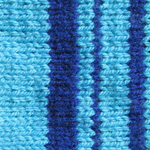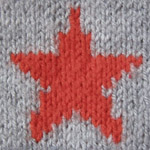UNDER CONSTRUCTION - Menu links may be unreliable for a short period.
Code Stripes
Just because something looks like random stripes doesn't mean it has to be. Knit secret information into your patterns like Madame Defarge, “bitter knitter and wine shop owner” from Charles Dickens' A Tale of Two Cities.
A code is a set of rules that is used to change one set of information into a different set of information. It needs to be possible to undo the rules and regain the original set of information, or it's a pretty useless code.
Substitution Code
(e.g. CODE => 3, 15, 4, 5)
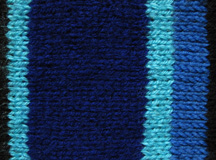
Choose the phrase you want to knit and then substitute every letter (and maybe the spaces/punctuation) for a specific value.
The simplest substitution is A=1, B=2, C=3, etc. Knit a stripe the given number of rows thick to encode your message. Aesthetically this simple code can look a bit weird because the stripes range in size so much, but it does the job.
Of course you don't have to encode information with just stripe width, you can substitute letters for anything you like, including colours and patterns. Here's a table for my own super secret knitted code that I made up just now. It's based on what colour I think letters ~feel~ like and how many points they're worth in Scrabble.
(The Scrabble thing was initially frivolous, but turned out to be a pretty good way to minimise the amount of knitting needed to encode something. The most common letters are the smallest stripes.)
| A | 1 row of orange dots. | N | 1 row orange. |
| B | 3 rows blue. | O | 1 row purple dots. |
| C | 3 rows yellow dots. | P | 3 rows purple. |
| D | 2 rows red. | Q | 10 rows purple. |
| E | 1 row blue dots. | R | 1 row red. |
| F | 4 rows blue. | S | 1 row yellow. |
| G | 2 rows orange. | T | 1 row blue. |
| H | 4 rows red. | U | 1 row red dots. |
| I | 1 row yellow dots. | V | 4 rows orange. |
| J | 8 rows red. | W | 4 rows purple. |
| K | 5 rows blue. | X | 8 rows yellow. |
| L | 1 row purple. | Y | 4 rows yellow. |
| M | 3 rows red. | Z | 10 rows orange. |
As I said at the top of the page a code is pretty useless if it can't be undone to get the original information. Upon knitting my substitution I found I needed to add two more rules in case same colour stripes occurred next to each other...
Letter Space: 1 row black.
Word Space: 4 rows black.
With these additions the table can also be used to decode the pattern.

The other codes we're going to look at are technically also substitution codes, but they're well known examples found in the real world, so I felt they deserved their own headings.
Morse Code
(e.g. CODE => – · – · – – – – · · · )
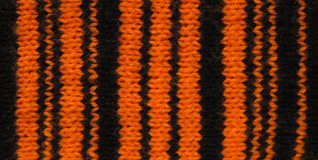
In Morse code each letter is represented by a series of dots and dashes. It can be transmitted by anything that can be turned off and on again. It the knitting above I've used colour to represent "on" and black to represent "off".
In my example dots and spaces-within-letters are one row stripes. Dashes and spaces-between-letters are three row stripes.
This table only shows the codes for letters of the alphabet but there are also official codes for numbers, symbols, instructions and non-English letters.
| A | · – | J | · – – – | S | · · · |
| B | – · · · | K | – · – | T | – |
| C | – · – · | L | · – · · | U | · · – |
| D | – · · | M | – – | V | · · · – |
| E | · | N | – · | W | · – – |
| F | · · – · | O | – – – | X | – · · – |
| G | – – · | P | · – – · | Y | – · – – |
| H | · · · · | Q | – – · – | Z | – – · · |
| I | · · | R | · – · |
ASCII
(e.g. CODE => 01000011 01001111 01000100 01000101)
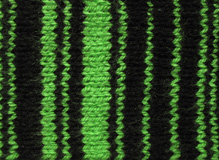
You might have seen the name “ASCII” in the context of saving a text file on a computer. It's a type of code that exchanges letter, number, and punctuation characters for binary codes so that computers can understand them. Each character has a code made up of ones and zeros only, and every individual code is the same length.
Convert your text into a series of ones and zeros using an ASCII table or conversion program. I'm not going to write out a table because ASCII doesn't limit you to letters or numbers and it's fun to browse the possibilities.
A single row of colour represents a one, a single row of black represents a zero. The tricky part of decoding knitted ASCII is to know the exact place to start. I really wish I'd marked the ends of the knitting with a colour change to make this more obvious. You could also space letters with another colour for ease of reading.
Bar Codes (and QR Codes)
(e.g. CODE => ![]() )
)

Barcodes are arrangements of black and white stripes of varying widths that encode information. QR Codes are similar except they use grid squares instead of stripes. This type of code is designed to be read by an optical scanner. A lot of smart phones have apps you can use to scan barcodes.
And yes, I scanned my knitting with an app and it read it correctly. It even works with the picture of the knitting above if you want to try it out. I was worried that the stripes where not clean edged enough but they work perfectly.
Generate the base for your pattern using a website such as this one. Here's a sample of the image I got for the word 'CODE'.
Now you need to translate the image into a knitting pattern. I did this putting a grid over the top, sizing it so that the narrowest stripe was one cell wide, then using this to judge the proportional size of the other stripes.
<<< See more Stripe Design Ideas.
© 2017 All desgins and images are copyright of ODDknit. If you enjoy the content of this website, please consider buying me a coffee at the link below.

